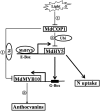The bZIP transcription factor MdHY5 regulates anthocyanin accumulation and nitrate assimilation in apple
- PMID: 28611922
- PMCID: PMC5461414
- DOI: 10.1038/hortres.2017.23
The bZIP transcription factor MdHY5 regulates anthocyanin accumulation and nitrate assimilation in apple
Erratum in
-
Erratum: The bZIP transcription factor MdHY5 regulates anthocyanin accumulation and nitrate assimilation in apple.Hortic Res. 2017 Oct 4;4:17056. doi: 10.1038/hortres.2017.56. eCollection 2017. Hortic Res. 2017. PMID: 29114391 Free PMC article.
Abstract
The basic leucine zipper (bZIP) transcription factor HY5 plays a multifaceted role in plant growth and development. Here the apple MdHY5 gene was cloned based on its homology with Arabidopsis HY5. Expression analysis demonstrated that MdHY5 transcription was induced by light and abscisic acid treatments. Electrophoretic mobility shift assays and transient expression assays subsequently showed that MdHY5 positively regulated both its own transcription and that of MdMYB10 by binding to E-box and G-box motifs, respectively. Furthermore, we obtained transgenic apple calli that overexpressed the MdHY5 gene, and apple calli coloration assays showed that MdHY5 promoted anthocyanin accumulation by regulating expression of the MdMYB10 gene and downstream anthocyanin biosynthesis genes. In addition, the transcript levels of a series of nitrate reductase genes and nitrate uptake genes in both wild-type and transgenic apple calli were detected. In association with increased nitrate reductase activities and nitrate contents, the results indicated that MdHY5 might be an important regulator in nutrient assimilation. Taken together, these results indicate that MdHY5 plays a vital role in anthocyanin accumulation and nitrate assimilation in apple.
Conflict of interest statement
The authors declare no conflict of interest.
Figures








References
-
- Ubi BE, Honda C, Bessho H et al. Expression analysis of anthocyanin biosynthetic genes in apple skin: effect of UV-B and temperature. Plant Sci 2006; 170: 571–578.
-
- Ban Y, Kondo S, Ubi BE, Honda C, Bessho H, Moriguchi T. UDP-sugar biosynthetic pathway: contribution to cyanidin 3-galactoside biosynthesis in apple skin. Planta 2009; 230: 871–881. - PubMed
-
- Honda C, Kotoda N, Wada M et al. Anthocyanin biosynthetic genes are coordinately expressed during red coloration in apple skin. Plant Physiol Bioch 2002; 40: 955–962.
-
- Zhang F, Gonzalez A, Zhao M, Payne CT, Lloyd A. A network of redundant bHLH proteins functions in all TTG1-dependent pathways of Arabidopsis. Development 2003; 130: 4859–4869. - PubMed
LinkOut - more resources
Full Text Sources
Other Literature Sources

